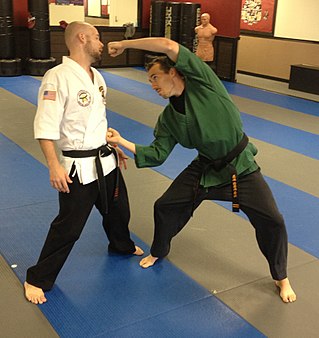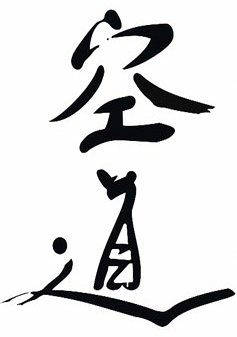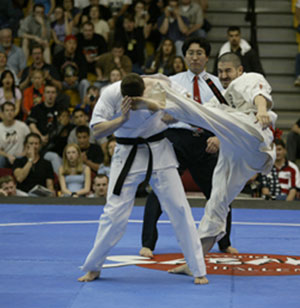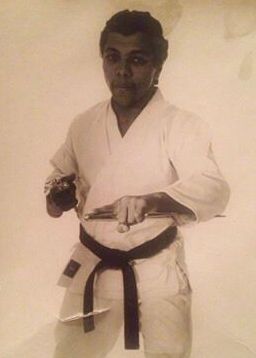
Kenpō is the name of several arts. The word kenpō is a Japanese translation of the Chinese word "quánfǎ". This term is often informally transliterated as "kempo", as a result of applying Traditional Hepburn romanization, but failing to use a macron to indicate the long vowel. The generic nature of the term combined with its widespread, cross-cultural adoption in the martial arts community has led to many divergent definitions. The word Kenpō translates thus: "Ken" meaning 'Fist' and "Po" meaning 'Method' or 'Law' as in 'Law of gravity', a correct interpretation of the word Kenpō would be 'Fist Method', the same meaning as 'Quanfa'. However, it is often misinterpreted as 'the Law of the Fist'.

In East Asian martial arts, the black belt is associated with expertise, but may indicate only competence, depending on the martial art. The use of colored belts is a relatively recent invention dating from the 1880s.
Danzan-ryū is a ryū of jujutsu founded by Seishiro Okazaki (1890–1951) in Hawaii. Danzan-ryū jujutsu is of mainly Japanese origin but is most common on the West coast of the United States. The Danzan-ryū syllabus is syncretic, and includes non-Japanese elements.

The dan ranking system is used by many Japanese, Okinawan, Korean, and other martial art organizations to indicate the level of a person's ability within a given system. Used as a ranking system to quantify skill level in a specific domain, it was originally used at a Go school during the Edo period. It is now also used in most modern Japanese fine and martial arts.

Jeff Speakman is an American actor and a martial artist in the art of American Kenpo and Japanese Gōjū-ryū, earning black belts in each. Between 2008 and 2018, he was President of the International Kempo Federation.

Gosoku-ryū (剛速流) is a style of karate which was founded by Takayuki Kubota. Gosoku stands for hard and fast, which suggests a combination of techniques both from the fast and dynamic Shōtōkan style as well as from the strength-focused Gōjū-ryū style.

The ISKA is one of the major international bodies regulating sport karate and kickboxing matches, and is based in the United States. It was established in 1985 as a response to legal and revenue issues that sent the Professional Karate Association (PKA) into decline.

A red belt is one of several colored belts used in some martial arts to either denote rank or differentiate opponents in a competition. Like the more commonly known black belt, its use varies between arts, with most using it for the style founder, grandmaster or other high rank, while others use it as the immediately pre–black belt rank or even to denote a beginner who holds no rank. In some schools, especially those with lineage related to Kodokan Judo, a red belt signifies ninth or tenth degree Dan rank, the highest ranks attainable.
Wah Leong Jay, better known as Wally Jay, was an American martial artist who primarily studied and taught jujutsu and judo. He was the founder of the Gendai Budo martial art Small Circle JuJitsu.
Small Circle Jujitsu is a style of jujutsu developed by Wally Jay that focuses on employing dual simultaneous push/pull actions and smooth transitions.
George Dillman in Philadelphia, Pennsylvania is an American martial arts instructor who popularized the use of fake techniques such as pressure points among the United States' martial arts practitioners. Dillman is a member of Black Belt magazine's Hall of Fame, and in 1997 was named Black Belt Magazine's "Martial Arts Instructor of the Year". For 30 years, he ran the Northeast Karate Championships. Dillman also conducts martial arts training seminars at the former Muhammad Ali training camp at Deer Lake, Pennsylvania. Dillman has been subject to scrutiny stemming from the fact that many of his most famous techniques don’t work, especially those involving alleged touchless chi manipulation.
The Jitsu Foundation or TJF is a national-level association of sports clubs headquartered in the United Kingdom, but also has affiliated organisations in other countries around the world. Focusing on standing throws and locks using weakening strikes to assist, the style taught within the association is known as Shorinji Kan Jiu Jitsu(少林寺完柔術).
Anthony Perosh is a retired Australian professional mixed martial artist who competed in the Light Heavyweight division of the Ultimate Fighting Championship.

Paul Creighton is a retired American mixed martial artist and Brazilian Jiu Jitsu black belt under Renzo Gracie who competed in the Lightweight division of the Ultimate Fighting Championship. His last fight in mixed martial arts competition, came at a losing effort at UFC 37: High Impact at the CenturyTel Center in Bossier City, Louisiana on May 10, 2002 against B.J. Penn.
Constantino 'Tino' Ceberano is a karate master who is a key figure in Australian martial arts history. He is a direct student of Gōju Kai karate founder Gōgen Yamaguchi (1909–1989). A native of Hawaii, Ceberano moved to Australia in 1966 at Yamaguchi's request, to establish Gōju Kai karate there.
Craig Pumphrey is a martial arts expert and Guinness World Record-holding professional breaker.

Richard Bustillo was an American martial arts instructor from Hawaii who was a student of the late Bruce Lee and an authority on Jeet Kune Do Concepts and Filipino Martial Arts.

Kūdō is a Japanese hybrid martial art. It is a full-contact combat sport that aims to achieve both safety and practicality, a style of mixed martial arts practised with headgear and gloves. It features stand-up striking, with throwing and grappling techniques being also allowed in the competition, including restraint, locks and chokeholds.

Karate was first introduced to American service men after World War II by Japanese and Okinawan karate masters.

Ronald M. Taganashi was an American martial arts science philosopher and teacher. Taganashi was the founder of the American-Te Goju-Ryu martial arts system. He also founded the North American Heaven and Earth Society, which encourages students to learn about themselves, their spiritual beliefs, and their art.











